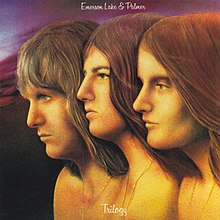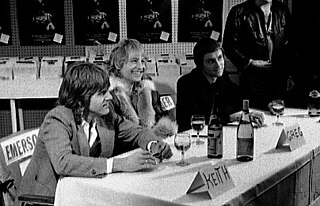
Emerson, Lake & Palmer were an English progressive rock supergroup formed in London in 1970. The band consisted of Keith Emerson (keyboards) of The Nice, Greg Lake of King Crimson, and Carl Palmer of Atomic Rooster. With nine RIAA-certified gold record albums in the US, and an estimated 48 million records sold worldwide, they are one of the most popular and commercially successful progressive rock groups of the 1970s, with a musical sound including adaptations of classical music with jazz and symphonic rock elements, dominated by Emerson's flamboyant use of the Hammond organ, Moog synthesizer, and piano.

Keith Noel Emerson was an English keyboardist, songwriter, composer and record producer. He played keyboards in a number of bands before finding his first commercial success with the Nice in the late 1960s. He became internationally famous for his work with the Nice, which included writing rock arrangements of classical music. After leaving the Nice in 1970, he was a founding member of Emerson, Lake & Palmer (ELP), one of the early progressive rock supergroups.

The Best of Emerson, Lake & Palmer is an album by British progressive rock band Emerson, Lake & Palmer, released in 1994. This supersedes a 1980 compilation with a shorter, different track list and Japanese ukiyo-e cover designed by Richard Evans.

Pictures at an Exhibition is a live album by English progressive rock band Emerson, Lake & Palmer, released in November 1971 on Island Records. It features the group's rock adaptation of Pictures at an Exhibition by Modest Mussorgsky, performed at Newcastle City Hall on 26 March 1971.

Tarkus is the second studio album by English progressive rock band Emerson, Lake & Palmer, released on 14 June 1971 on Island Records. Following their debut tour across Europe during the second half of 1970, the group paused touring commitments in January 1971 to record a new album at Advision Studios in London. Greg Lake produced the album with Eddy Offord as engineer.

Brain Salad Surgery is the fourth studio album by English progressive rock band Emerson, Lake & Palmer, released on 19 November 1973 by their new record label, Manticore Records, and distributed by Atlantic Records.

Works Volume 1 is the fifth studio album by English progressive rock band Emerson, Lake & Palmer, released as a double album in March 1977 on Atlantic Records. Following their world tour supporting Brain Salad Surgery (1973), the group took an extended break before they reconvened in 1976 to record a new album. They were now tax exiles and recorded new material in London and overseas in Montreux, Switzerland and Paris, France. Works Volume 1 features a side dedicated for each member to write and arrange their own tracks, while the fourth side features songs performed collectively. Keith Emerson recorded his Piano Concerto No. 1, Greg Lake wrote several songs with lyricist Peter Sinfield, and Carl Palmer recorded tracks of varied musical styles.

Gregory Stewart Lake was an English bassist, guitarist, singer, and songwriter. He gained prominence as a founding member of the progressive rock bands King Crimson and Emerson, Lake & Palmer (ELP).

Manticore Records is a record label launched by the Manticore production company in 1973. These companies were owned by the members of the progressive rock group Emerson, Lake & Palmer and their manager, Stewart Young. The manticore was first featured in the artwork for the second ELP album Tarkus, as one of the eponymous creature's adversaries. Manticore was initially the name given to ELP's music publishers, credits first appearing in the credits on Trilogy, released on Island in 1972.
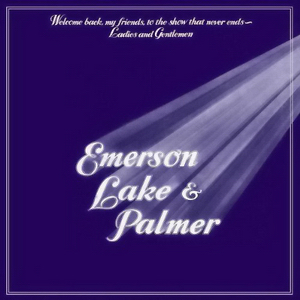
Welcome Back, My Friends, to the Show That Never Ends – Ladies and Gentlemen is the second live album by the English progressive rock band Emerson, Lake & Palmer, released as a triple album in August 1974 on Manticore Records. It was recorded in February 1974 at the Anaheim Convention Center in Anaheim, California, during the group's 1973–74 world tour in support of their fourth studio album, Brain Salad Surgery (1973).

Emerson, Lake & Palmer is the debut studio album by English progressive rock band Emerson, Lake & Palmer. It was released in the United Kingdom by Island Records in November 1970, and in the United States by Cotillion Records in January 1971. After the group formed in the spring of 1970, they entered rehearsals and prepared material for an album which became a mix of original songs and rock arrangements of classical music. The album was recorded at Advision Studios in July 1970, when the band had yet to perform live. Lead vocalist and bassist/guitarist Greg Lake produced it.
"Tarkus" is the title track of Emerson, Lake & Palmer's second album. The progressive rock epic lasts 20:35. It was the longest studio suite by the band until the three impressions of "Karn Evil 9". The name "Tarkus" refers to the armadillo-tank from the William Neal paintings on the album cover. The artist has explained that the name is an amalgamation between 'Tartarus' and 'carcass'. Consequently, the name refers to the "futility of war, a man made mess with symbols of mutated destruction." The song "Tarkus" supposedly follows the adventures of Tarkus from his birth, through a fight with a manticore, which he loses and concludes with an aquatic version of Tarkus named "Aquatarkus". Keith Emerson, when asked what work he is proudest of, named his "Piano Concerto" and "Tarkus".

Emerson, Lake and Palmer in Concert is a live album by Emerson, Lake & Palmer (ELP), recorded at their 26 August 1977 show at the Olympic Stadium, Montreal, Quebec, Canada which is featured on the album cover. It was released by Atlantic Records in November 1979, following ELP's breakup. It was later re-released and repackaged as Works Live in 1993. Some of the tracks were not from the Montreal concert, but from other concerts during their 1977–1978 tour, such as "Peter Gunn" and "Tiger in a Spotlight".

Emerson, Lake & Powell, sometimes abbreviated as ELP, were an English progressive rock band, considered by many as a variant lineup of Emerson, Lake & Palmer, that released one official studio album in 1986. The album's debut single was "Touch and Go," which peaked at number 60 on the Billboard charts on 19 July 1986.

In the Hot Seat is the ninth and final studio album by English progressive rock band Emerson, Lake & Palmer, released on 27 September 1994 by Victory. Recorded at Goodnight L.A. Studios in Los Angeles, it was produced by Keith Olsen.
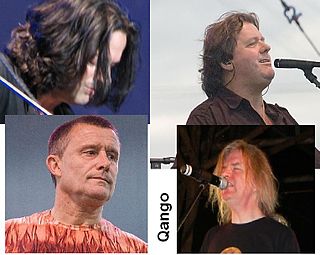
Qango were a short-lived progressive rock band, a spin-off from Asia. In 1999, an attempt was made at a partial reunion of the progressive rock supergroup Asia involving John Wetton, Carl Palmer (drums) and Geoff Downes (keys), with Dave Kilminster to be on guitar. However, Downes withdrew from plans, choosing to stick with John Payne in their Asia line-up. Wetton and Palmer instead formed Qango with Kilminster and John Young on keys. The band's live set was based on songs by Asia and Palmer's former band Emerson, Lake & Palmer.

"From the Beginning" is a song written by Greg Lake and performed by the progressive rock trio Emerson, Lake & Palmer. It was released on their 1972 album Trilogy. It hit #39 in the United States and was their highest charting single there.

From the Beginning is a box set which presents aural and visual documentation celebrating Emerson, Lake & Palmer's career; consisting of five discs that include a number of single b-sides, significant live recordings, alternative studio mixes and material taken from band rehearsals, plus a bonus DVD featuring 'The Manticore Years' documentary, presented in a deluxe book-style sleeve complete with a 60-page picture booklet containing extensive sleeve notes by the band discussing the ELP years. It also contains rare and previously unseen photographs and images.

"Lucky Man" is a song by the English progressive rock supergroup Emerson, Lake & Palmer, from the group's 1970 self-titled debut album. Written by Greg Lake when he was 12 years old and recorded by the trio using improvised arrangements, the song contains one of rock music's earliest instances of a Moog synthesizer solo. "Lucky Man" was released as a single in 1970 and reached the top 20 in the Netherlands. The song also charted in the United States and Canada. The single was re-released in 1973 and charted again in the U.S. and Canada.
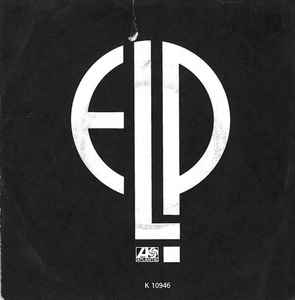
"Fanfare for the Common Man" is an instrumental piece of music adapted and played by the English progressive rock band Emerson, Lake & Palmer, from the group's 1977 Works Volume I album. Adapted by Keith Emerson from Aaron Copland's 1942 piece of the same name, it is one of their most popular and enduring pieces.
